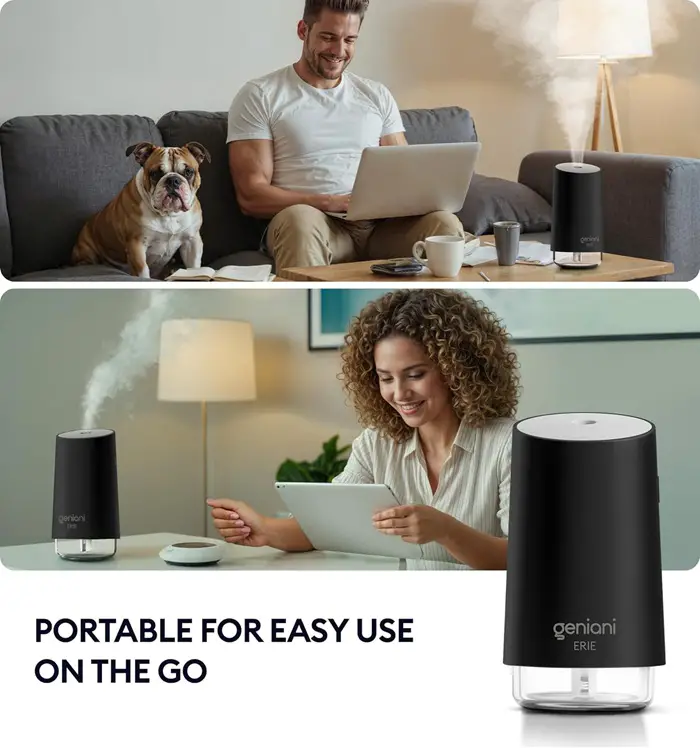
Waking up with gritty, burning eyes—like there’s sand trapped under your eyelids—can be incredibly frustrating.
Dry eyes don’t just cause discomfort; they interfere with focus, productivity, and even restful sleep.
I’ve experienced that struggle firsthand, trying countless drops and ointments that only brought short-lived relief.
Then I turned to a simple yet powerful solution: a humidifier. By adding moisture back into the air, it brings a level of soothing comfort that eye drops alone rarely provide.
Still, while a humidifier can be a real game-changer, it’s important to weigh both the pros and the cons before making it part of your daily routine.
Dry Eyes Causes and Symptoms
Dry eyes aren’t just an inconvenience—they can turn simple daily activities into a constant struggle.
The condition happens when your eyes don’t have enough moisture to stay comfortable, either because the glands aren’t producing sufficient tears or because the tears themselves lack the right balance of water, oil, and mucin.
The result is eyes that feel irritated, itchy, gritty, or as though they’re burning. In some cases, the eyes may even water excessively, blur your vision, or feel heavy and fatigued.
Whether it’s reading, working on a computer, or wearing contact lenses, dry eyes can make everyday tasks feel far more challenging than they should.
The causes behind dry eyes are just as varied as the symptoms. Aging naturally reduces tear production, and hormonal changes—especially in women—can make the problem worse.
Certain medications (like antihistamines, antidepressants, and birth control) can also strip away essential moisture. Medical conditions such as thyroid disorders, rheumatoid arthritis, and lupus, along with issues like eyelid inflammation or long-term contact lens wear, often play a role too.
Beyond these internal factors, the environment around us has a major impact. Think dry weather, constant exposure to air-conditioning or central heating, smoky or polluted air, and long hours in front of digital screens. Each of these slowly robs the eyes of much-needed hydration.
This is where practical solutions like using a humidifier come into play—helping restore balance in the air and giving your eyes the comfort they’ve been craving.

Benefits of Using a Humidifier for Dry Eyes
Adding a humidifier to your space can make a remarkable difference when it comes to relieving dry eyes.
By raising humidity levels and putting essential moisture back into the air, a humidifier slows down the evaporation of tears and helps your eyes stay hydrated for longer.
This creates a soothing environment, whether you’re working at your computer, driving long hours, or simply trying to rest without waking up to burning, irritated eyes.
Along with easing dry eyes, a small USB humidifier, with compact designs, makes them easy to place on your desktop, bedside, or even carry during travel.
- A USB-powered humidifier is especially handy for personal use at work or on the go.
- They help weigh down dust, dirt, and allergens floating in the air, reducing eye irritation and lowering the risk of infections.
- Relieve dry skin, nasal congestion, cough, or sinus irritation, making it a true multi-benefit gadget.
- Many mini humidifiers allow you to add a few drops of essential oil to enjoy a refreshing scent while keeping your eyes moist and your mood uplifted with an aromatherapy option.
Available in modern, attractive designs, these devices enhance your workspace while consuming very little power.
Plus, they operate silently, so you can use them personally without disturbing anyone around you.

Drawbacks of Using a Humidifier for Dry Eye Syndrome
While a humidifier can be a powerful tool for easing dry eye discomfort, it’s not a perfect solution — and understanding its limitations will help you use it more effectively.
1- Not a standalone fix – A humidifier can soothe symptoms, but it won’t treat the root cause of dry eyes on its own.
Combining it with other strategies — such as using lubricating eye drops, applying warm compresses, limiting contact lens use, and taking regular screen breaks — is essential for lasting relief.
2- Water quality matters – Using regular tap water may introduce minerals, chemicals, or debris into the air.
This can actually irritate your eyes instead of helping them. For best results, always use distilled or filtered water in your humidifier.
3- Maintenance is crucial – A humidifier that isn’t cleaned frequently can become a breeding ground for bacteria and mold. This contaminated mist can worsen eye irritation, cause redness, or even trigger allergic reactions.
4- Too much humidity can backfire – while a moderate level of moisture is beneficial, excessive humidity can lead to mold buildup in your space — and that’s another potential source of eye and respiratory irritation.
5- Consistency is key – Sporadic use, like running your humidifier only at the office and not at home, may limit its effectiveness.
For real improvement, consistent humidity control across your daily environment is necessary.

Factors to Consider When Picking a Humidifier for Irritated Eyes
Not all humidifiers are created equal, and choosing the right one can make a huge difference in how well it relieves eye dryness and discomfort.
Here are the most important factors to keep in mind:
1- Ease of Use – A humidifier should make your life easier, not more complicated.
Models with automatic controls and easy refills save time and effort, though even simple manual units can be stress-free if designed well. Look for features that fit your daily routine.
2- Size and Coverage – The larger the humidifier, the bigger the area it can keep moist.
A small unit may work well for a personal workspace, but for bedrooms or living rooms, a larger machine ensures consistent comfort.
Also, keep in mind that a bigger tank means fewer refills and steady moisture throughout the day.
Small tanks, while portable, need constant checking and topping up, which can become a hassle. Decide whether convenience or portability matters most to you.
3- Noise Level – Some humidifiers can be surprisingly noisy, which is distracting if you’re working at your desktop or trying to sleep.
If you’re sensitive to sound, opt for a quiet or “whisper-silent” model so the soothing mist doesn’t come with unwanted background noise.
4- Desktop Placement – For office use, a USB-powered desktop humidifier is often the best choice.
Close-range units deliver moisture exactly where you need it—right at eye level while working on a computer—making them perfect for anyone dealing with digital eye strain.
5- Efficiency and Durability – Performance varies widely. Some humidifiers can run 24 hours straight and cover large areas, while others are designed for small, personal spaces.
Durability also matters—sturdy construction ensures the unit won’t give up on you after just a few months of use.
Best Humidifier and Ideal Humidity Levels for Dry and Sore Eyes Relief
When choosing a portable cool mist humidifier for dry eyes, the type of device and the humidity level it provides are just as important as its convenience.
The most suitable humidifiers for eye comfort are usually evaporative or ultrasonic models, as they deliver a consistent, clean mist without introducing contaminants that could worsen irritation.
If you spend long hours in dry climates, offices, or in front of screens, a desktop or portable USB humidifier (like the GENIANI USB Powered) can help maintain consistent moisture around your eyes.
Is steaming good for dry, stinging eyes?
Steaming your eyes provides a natural, soothing way to ease discomfort caused by stinging eyes, sensitive eyes, or burning eyes from dry eye syndrome.
Similar to a humidifier, clean, gentle steam temporarily increases moisture in your eyes, helping them feel refreshed and more comfortable.
The added hydration also stimulates tear production, which not only keeps your eyes moist but helps flush out debris that can worsen irritation.
After steaming, always use a clean, warm cloth to gently wipe your eyes, ensuring they stay fresh and free from contaminants.
Maintain proper humidity levels and avoid extreme humidity
Keep indoor humidity between 45% and 65% to protect your tear film and reduce dryness. Levels below 45% can worsen eye irritation and ocular discomfort.
Excessive moisture can irritate your eyes and affect your vision. Balance is key: neither very low nor very high humidity is healthy for your eyes.
Also, look for a humidifier with a strong mist output, but avoid units that produce polluted or poorly maintained vapor.
Final Thoughts
Portable humidifiers are an excellent solution for anyone struggling with dry, stinging, sensitive, or burning eyes. They’re convenient, effective, and available in a variety of stylish designs that fit perfectly on your desktop or bedside table.
When choosing, make sure the humidifier is made of high-quality materials and comes with a proper warranty—this ensures long-lasting performance and peace of mind.
With the right device, you can enjoy soothing humidity, cleaner air, and even the gentle aroma of essential oils, creating a healthier and more comfortable environment for your eyes every day.
Meen Smith is a nurse by profession who loves writing online, spending time with her family and caring for the elderly. She has already worked as an associate editor on various moms, babies, home appliances, kitchen, and healthy living blogs. In her spare time, she also enjoys drawing, reading/writing kindle eBooks and improving her skills a bit.

